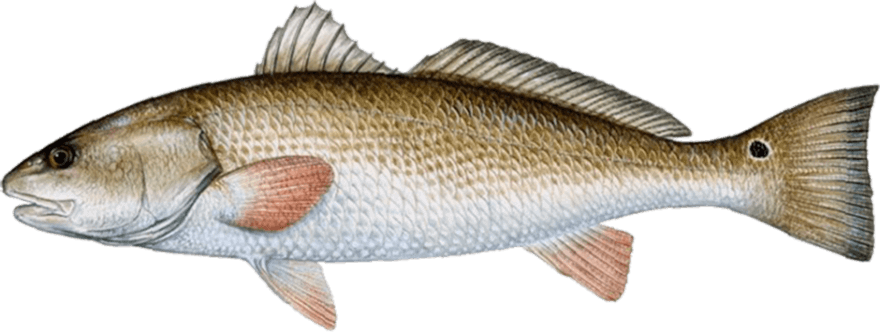By Capt. Dave Stewart
Giant red drum, aka “old drum” or bull reds, were designated the North Carolina state fish in the 1970s. Their habit of hanging around in North Carolina coastal water has a lot to do with that designation. Most anywhere else redfish range, a 50- or 60-pound red drum would be newsworthy, possibly even a state record. In North Carolina, old drum of that size are a regular occurrence for anglers fishing the waters connected to Pamlico Sound.

These fish spend the winter out in the Atlantic around deep wrecks and reefs. As the waters warm, they travel inshore into and through the inlets ending in the Pamlico Sound, Neuse and Pamlico River regions. The timing of this event is largely dependent on water temperature and bait. Massive schools of menhaden populate these rivers and provide massive feeding opportunities. Bull reds are here for food and fun. Around full moons of August and September, they spawn on the numerous oyster rocks in the region.
Beginning in about May, great surf and pier fishing as well as boat fishing around inlets and bars takes place as fish move in through Ocracoke and Hatteras inlets as well as Drum, Barden and Beaufort inlets.
One of the local longtime Ocracoke guides is Capt. Norman Miller. He has been fishing these waters for years and treats his clients to a world-class fishery. Ocracoke is the entry into the spawning grounds. Capt. Miller targets these fish along the beach by looking for bait balls and feeding drum and then casting big bucktails to entice a strike. When they hit, hang on! He will also set up around sloughs and channels around inlet shoals and fish bait on circle hooks. Fresh mullet or menhaden are the preferred baits. Old drum hang around the inlets for a month or two before heading into the sound around the new and full moons of June. During the summer, Capt. Miller goes into the sound, fishing bait on circle hooks on windblown ledges late in the evenings and very early in the mornings.
Ocracoke is a great fishing village and an awesome vacation spot with quiet beaches, great food and lodging. There are also various dockage options for boaters.
As drum travel into the Pamlico Sound, they can be targeted around the deeper drops of shoals and rocks in the sound with fresh bait on circle hooks. Incidental catches happen in the sound and rivers while targeting trout and slot drum as early as June. It presents a challenge, but you can get them in on light tackle if you handle situation correctly. The full wave generally starts in late July or early August and runs through September, lasting sometimes into early October.
I carry my clients of KneEDeep Custom Charters out of Minnesott Beach, N.C. in search of an exceptional experience. Minnesott Beach is near Oriental, N.C. The town offers lodging and fine local seafood at Gary’s Down East Restaurant. Oriental has lodging and restaurants as well, with Neuse River Suites being the best place to stay riverfront in walking distance to local establishments.
With reds schooling into the Pamlico and Neuse, I cruise in search of large bait pods. When we find them, we ease into casting distance with trolling motor and clients throw DOA Popping Cork rigs baited with DOA AH Swimbaits into and around the bait. Noise is the key. Aggressive popping gets the drums’ attention, the bait falls and the fish will smack the rod out of your hand if you’re not ready. We also use large Storm and Rapala topwater popping baits to entice an explosion. This style of fishing is incredibly exciting. We do it in daylight hours, which makes the crazy activity of these fish fully visible. The drum are there to eat and spawn! Find the bait, and odds are in favor of a hook-up.
Soaking bait is also a viable tactic to target these beasts, you just need fresh bait and plenty of it. Bait stealers eat well. If you don’t check bait every several minutes, you are probably fishing on credit. If there are no bait stealers, move. Drum will be with other species. Bait your circle hook, using a defined legal rig at night, and keep a tight line. Set up on drops, holes and ledges around shoals or rocks… if you are fortunate to have coordinates of good ones. I like to measure fish in the water with a floating measure stick, Drum Stix, to keep from stressing the drum and my back.
After the full moon of September, the first cold fronts begin to move in – Mullet Blows – and the drum make an exit toward the inlet and then back to the ocean. It’s a vicious cycle. See a seven minute video below on Catching Big Reds with Capt. Dave Stewart.
Contact Capt. Dave Stewart and KneEDeep Custom Charters at 252-670-2841, specfever@hotmail.com or www.pamlicotackle.com. Contact Capt. Norman Miller at 252-921-0180, fishrascal@gmail.com or www.ocracokeharborinn.com.
